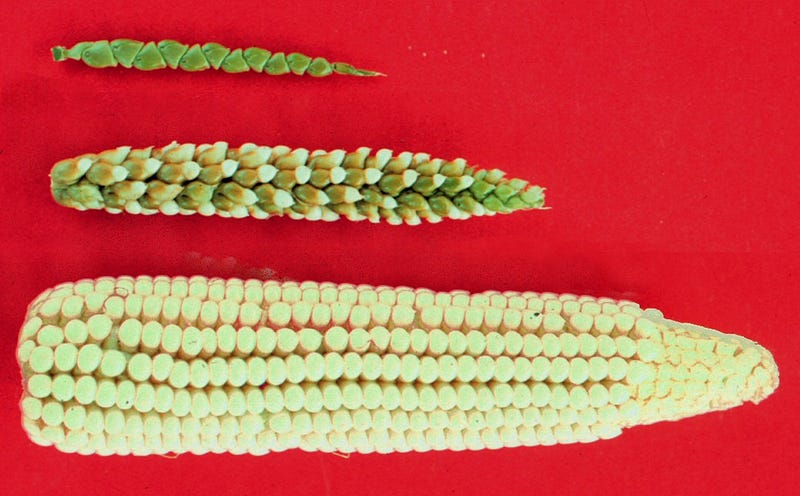Genetic modification of plants is humanity’s oldest and best trick. Eurasians had it easy when it came to cultivating wheat — its original form was pretty close to its present cultivated one. Mesoamericans, on the other hand, had to work for centuries to cultivate corn (or maize) from its origins as an inch-long bundle of dry seeds into the cobs of succulent kernels we know today.

The process has radically improved over the last 12,000 years. The traditional process of spending centuries on observation, cross-breeding, and trial and error iteration has been replaced with the ability to microscopically target specific genes and to “invent” and propagate new species of plants almost instantaneously.
The process of genetic engineering that brings about GMO food does seem suspicious.
DNA strands are cultured in a bacterium and inserted into the host plant’s nucleus using a virus. “Bacterium” and “virus” are not the kinds of things people want associated with their food. The knee-jerk reaction to say “GMOs are bad” is thus natural and understandable.
Natural and understandable as suspicions about GMOs’ effects on human health may be, it is completely unfounded.
That said, there are two very good reasons to be wary about GMOs: implementation and efficacy.
Regarding implementation, most GMO plants produced and consumed in the US today are those that allow for resistance to a specific herbicide — Monsanto’s Roundup. Roundup Ready soy, corn, and beets grow from seeds that have been genetically modified to grow even when glyphosate weed killer (Roundup’s scientific name) is applied to them.

While Roundup has not tested as toxic to humans and other mammals, the longer it has been on the market, the worse its effects on soil health and long-term plant fecundity appear. In addition, Roundup Ready plants may not allow necessary micronutrients to be absorbed by animals consuming them and may also play a part in the recent die-off of bees (the seriousness of whichcannot be overstated).
Aside from the biological concerns, there are also economic ones about which any farmer is certainly well-acquainted. Monsanto has been known to use its enormous reserves of wealth to hire lawyers to crush small farmers with lawsuits and even to hire Internet trolls to intimidate end consumers who question Roundup’s health effects.
While these are specific issues related to Monsanto’s evil empire, more generally, I am concerned about farming methods that fine-tune production to a very narrow set of ecological conditions, especially since climate change is very clearly pushing the envelope of historical agricultural conditions.
As I mentioned in an earlier article, California — America’s vegetable store — has recently experienced its most severe drought since at least 1571, and the scientist who published these findings believes that it may take decades for the region to fully recover. Considering that climate change makes future drought events relatively more likely, you can see the potential for a dangerous one-two punch to California’s agricultural industry.
In my region of the Midwest — America’s bread basket — scientists are warningof the rapid depletion of the very slowly recharging Ogallala Aquifer. It is not too early to consider that the amber waves of grain in the Midwest might also be at risk of drought (or conversely that the risk of crop-harming downpours — another manifestation of climate change — will also negatively affect grain yields).

In light of these very sobering conditions, it is clear that agricultural technology should be focusing on increasing the resiliency of our food crops, rather than fine-tuning them to maximize yield in a narrow ecological sweet spot.
This brings me to the second problem with GMO crops — efficacy.
When I was researching this article, I looked for examples of companies working on developing GMO strains that were drought-resistant or would otherwise allow crops to be grown in soils with less nitrogen (i.e., lower fertilizer levels) and the like. I found Monsanto had marketed a drought-resistant corn product, but that this has not had great commercial uptake and its efficacy was questioned by a scientific study.
Then, I found a tiny ($25 million market cap), California-based company whose CEO is a Monsanto alum, called Arcadia BioSciences RKDA. Arcadia has formed a joint venture with an Argentinian bioengineering firm to produce a drought-resistant soybean seed. As you might be able to tell by the very small market capitalization, it’s safe to say that Arcadia’s drought-resistant soybeans have not yet taken the world by storm.
Digging further, I found a story in the science journal, Nature, that talks about the work done by a Mexico City-based organization, International Maize and Wheat Improvement Center (CIMMYT). CIMMYT has built a seed bank and has done the painstaking work (started by their long-distant ancestors) of observing plants and cross-breeding them to create drought-resistant maize varietals.

Lo and behold, the cross-bred strains generated yields up to 30% higher than commercial seeds under drought conditions. According to the researchers:
Drought tolerance is a complex trait that involves multiple genes. Transgenic techniques [N.B. genetic engineering used in GMOs], which target one gene at a time, have not been as quick to manipulate it.
There is a place for the genetic modification of crops; for instance, altering the times of the day during which plant respiration occurs may be an important field of research and development in the future. However, from my reading, these solutions are likely in what I term the Revolutionary Development stage — 10 years or more from economic commercialization.
The moral of the story is that there is no reason to be frightened of the technology behind GMO crops. Genetically modified foods may someday provide integral assistance to allow humans to successfully adapt to changing climactic conditions and, in so doing, may enrich far-sighted investors.
You should, however, be very worried about the current implementation of GMO due to its effects on cropland, the ecosystem, and human health, and that research into GMOs is taking resources away from potentially much more helpful cross-breeding projects in the short run.
